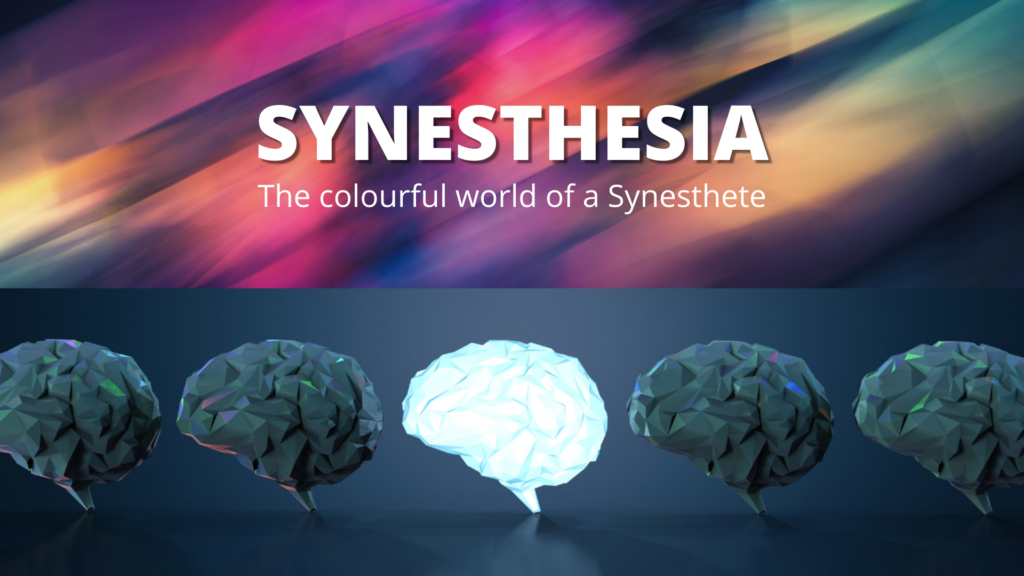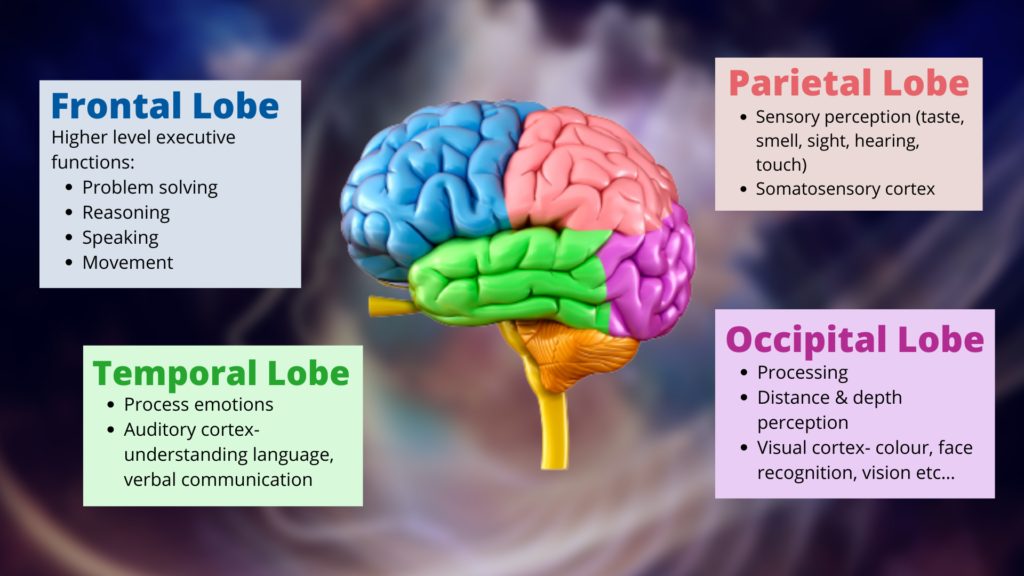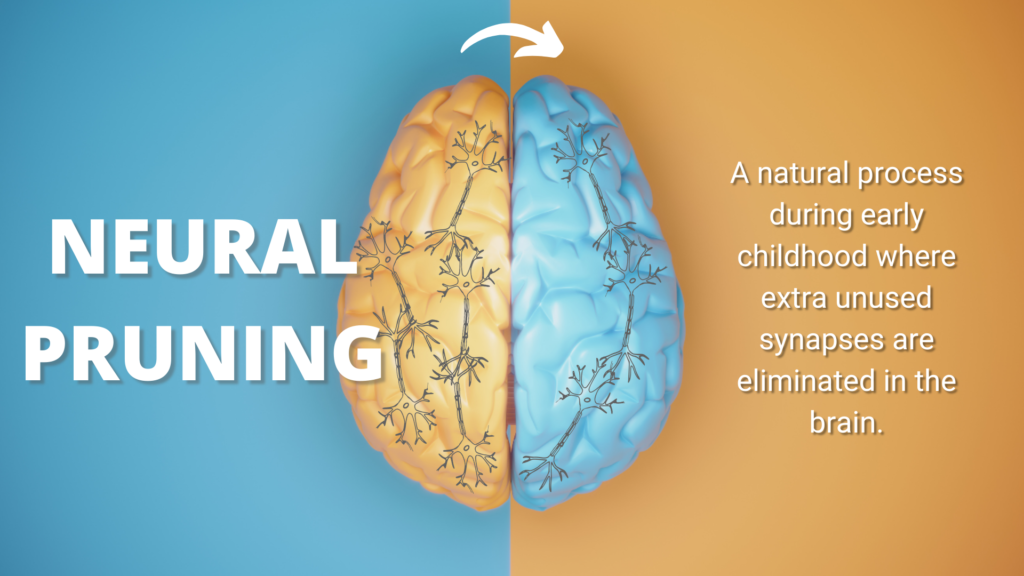Do you see colors when you listen to music? Is the word ‘Thursday’ a very specific color to you? Maybe you can taste certain words. Neurological conditions don’t all have to be life-threatening, dangerous disorders, sometimes you can taste words. This happens when two or more of your senses are perceived at the same time by your brain. With over 60 different forms of synesthesia, synesthetes hide in plain sight, using their little unique superpowers to empower them and enjoy life.
Could you have Synesthesia?
Table of Contents
What is Synesthesia?
Synesthesia is a condition where one sense is perceived at the same time as another sense. The best way to explain synesthesia is through examples. Imagine you see days of the week but each day has a very specific color. You hear “Monday” and see the color green. You hear “Tuesday” and see the color red. Likewise, you can hear a sound, Major C, and see the color red. Or you might see the word “raindrop” and feel a bitter taste in your mouth.
The word “synesthesia” originates from Greek. “Synth” in Greek means “together” and “esthesia” translates to “perception”. Hence synesthesia means “perception together” or mixed perceptions. Synesthesia is rare and there is very little research done on this phenomenon but it has been found that approximately 2-4% of the population is synesthetes. These mixed sensations cannot be experienced by everyone, and it’s important to note there are many different forms and types of synesthesia and one can experience more than one type as well.
There are two subsections of synesthesia:
- Projective Synesthesia: when the image or color is projected directly in front of you in your visual field
- Associative Synesthesia: when the image or color lights up in your mind
Different forms of Synesthesia
There are many different forms of synesthesia;
- Grapheme-color synesthesia – is probably the most common among synesthetes, where letters, words or numbers are associated with colors. And most of the time, these colors don’t change with time either. Studies have found that most groups of synesthetes of this kind experience the same colors to words/numbers (ex: A is red)
- Sound-to-color synesthesia (Chromesthesia) – is when some sounds induce shapes or colors as the person hears the sound. Those with Chromesthesia are often found to also have perfect pitch (an ability to identify the pitch exactly as played) because this skill of being able to SEE the coolers of the notes enables them to identify the notes easier. (Ex: Middle C note is Red, or lower pitch sounds are dark colors)
- Auditory-tactile synesthesia – is when certain sounds induce sensation in different parts of the body. For example, a certain sound may feel like someone is touching your arm when there is no one touching you, so a sensation is created through hearing that specific sound. This is a rare form of synesthesia.
- Lexical-gustatory synesthesia – another rare type where words and sounds may induce different tastes. For example, the word football may taste like blueberries.
- Mirror-touch synesthesia – this is an odd type of synesthesia where you feel the same sensation as someone else (touch). For example, if your friend is being tapped on the shoulder, you feel this sensation yourself and check your shoulder but there is no one tapping you. Sounds a little creepy, doesn’t it?
Other types of synesthesia include kinesthetic synesthesia, spatial sequence synesthesia, number form and many more.

Is It Genetic or Environmental?
There is very little research on synesthesia however research has found that approximately 40% of synesthetes have a relative with the condition as well showing this condition could have a heredity origin as well. And because there are at least 60 different types of synesthesia, the condition shows heterogeneity where each type of synesthesia could be caused by different genes. There may also be silent genes where the condition is not expressed in individuals however it is passed down to the next generation.
But that makes you wonder why this gene was preserved and passed down generations as a form of survival? How can seeing colours in words possibly be a survival tactic?
It has been found that those with synesthesia have incredible memory abilities as they can memorise certain things by associating with colours or different senses. For example, English essayist Daniel Tammet found that his synesthesia helped him to memorise pi to 22,514 digits. Likewise, synesthetes can memorise numbers, locations, and words, through their associations with the other senses which come in handy as we go about our day-to-day lives.
Berit Brogaard, a Danish-American philosopher, has a rare form of synesthesia where her fearful thoughts induce an image of a scary landscape to appear right in front of her eyes. In her book The Superhuman Mind: Free The Genius in Your Brain, she described it as fear-induced synesthesia. She explained that the stronger the fear is, the more vivid her image become. Her abilities eventually helped save her life. She explained that she was hiking on a trail and the image flashed right in front of her eyes. She was able to see past the image and see that she was about to step on a poisonous snake even though her consciousness had not processed the threat yet. Through her synesthesia, her brain had warned her of the threat in front of her faster than her brain could process it.
However, it is possible to develop synesthesia through practice as well. Brogaard explained that we can develop connections with the different senses. If it’s sound and color, we can practice our minds to associate a color with a particular note and develop new pathways. So eventually, the brain will associate that color with the note as practiced and it becomes automatic and instant. Brogaard went on to explain further that as humans we remember things associated with emotions and color the best.
The Science behind the Colors
Neurobiology of the brain
The brain is made up of several different sections almost like compartments including the motor cortex of the frontal lobe, somatosensory cortex of the parietal lobe, auditory cortex of the temporal lobe, and visual cortex of the occipital lobe of the cerebral cortex. Each lobe is responsible for many different functions of the mind and body;
- Frontal Lobe controls problem-solving, reasoning, emotional perception, speaking, and movement through the motor cortex – the higher level executive functions.
- Parietal Lobe is important for sensory perception including our five senses – taste, hearing, sight, touch and smell as well as the primary somatosensory cortex responsible for signal interpretation.
- Temporal Lobe is vital for processing emotions (limbic system), and auditory information from the auditory cortex involving understanding language and verbal communication through memory and hearing.
- Occipital Lobe is known as the processing region of the brain where processing takes place as well as distance and depth perception and visual input through the visual cortex including determining colour, face recognition, vision etc…

Neurobiology of Chromesthesia
Now that we’re familiar with the lobes of the brain, how does a synesthete’s brain differ from a non-synesthete’s? In simple, the different cortexes and lobes of the brain are more strongly interconnected so that when an area is activated (auditory cortex listening to music), the other region is also activated alongside it (the visual cortex producing images or colours that Chromesthetes see).
Chromesthesia was found in 5-15% of the adult population in research and most having the condition from a very early age. In the case of Chromesthesia, scientists have found that both the auditory and visual cortexes light up immensely when the synesthete listens to music – this is known as Cross-activation or cross-modal association.
Cross-modal association activates the limbic system (controlling mood, beahviour and emotions) on the left side of the brain and reduces the flow of blood to the region processing information (neocortex) and then activates both the visual and auditory cortexes of the brain.
But how does cross-modal association even begin? Some research leads to the process called Neural Pruning. As the brain grows in an infant, many new neural connections are created and the stimulated connections (synapses where nerve impulses travel between two nerves) are strengthened while the unused connections are eliminated or pruned. And so a failure to prune may result in extra connections between different areas of the brain where senses are mixed and perceived together. Cross-modal association may develop due to a failure of pruning.

Therefore, those with chromesthesia are also known to have an even stronger emotional connection to the songs they listen to as their mood is triggered by coolers the music produces (yellow or green for happiness, blue for sadness).
Chromesthesia in Pop Culture
Pop culture is filled with artists and musicians with chromesthesia, those who use their abilities to transform them into even better artists.
- Lorde
“From the moment I start something, I can see the finished song, even if it’s far-off and foggy,”
Lorde is one artist who uses her chromesthesia to produce top songs. She explained to The New York Times Magazine that she has already seen the song when she starts, so it was just a matter of sharpening the colours until the right chords, emotions and textures complete the song through her synesthesia.
She used her chromesthesia for her song “Green Light” which was meant to represent a green traffic light. And in a 2015 Tumblr Q&A, she explained that her song “Tennis Court” (2013) was at first, too tan, and so she developed the song further to turn it into a different colour (green) with its pre-chorus.
- GAYLE
“I wrote a song I liked, and for whatever reason, I always came back to it thinking there was just something about it. I couldn’t figure out why I didn’t – and couldn’t – love this song […] then it hit me – I didn’t like the colour of it, and I didn’t know how to explain it to people.”
The singer of the hit song “abcdefu” explained that she found that she had chromesthesia when she couldn’t bring herself to like one of her songs. She liked the melody and lyrics but realized she didn’t like the colour of the song. GAYLE went on to further explain that she feels very strongly about aesthetics and colours in the songs and realized this as she was working on single covers to match her songs. With this determination to get the right colour of each song, she works to ensure the colours don’t clash together and portray her colours in her music videos and cover art which brings something special to the table that we don’t see in many other artists.
“Sometimes it felt like the art was green, but the song was yellow – it didn’t fit. I started to use my chromesthesia to my advantage when it came to what I wanted to do visually, and it made me better.”
Perhaps that’s why “abcdefu” did exceptionally well on the charts, all thanks to her musical colours.
“I see colour and sometimes even objects and textures when I listen to music.”
In 2017, Miller released three mini albums which she referred to as “chapters”. Chapter 1: Blue, Chapter 2: Red and Chapter 3: Yellow. When asked, she said that the slow sad songs were blue, the empowering and angry ones were red, and the songs in between those were yellow. And of course, we notice that these colours are the primary colours. Miller explained to DuJour saying, “I feel you can make any colour in the entire world with those three primary colours. So, the same way you need the three primary colours to experience the other colours, you need to feel those emotions of anger, sadness and happiness in order to be who you want to be.”
Her music videos are associated with the colours that the song evokes. For example, if we take a look at her video, i can’t breathe from Chapter 1 the song itself and the lyrics are melancholy. She talks about feeling trapped and the instruments used in the song bring out a desolated but calming experience. In her video, she emphasises the colour blue, highlighting it in her dress, or the flowers on the piano.
On the contrary, if we look at her music video from Chapter 2 of her collection, buy me diamonds, Miller highlights the colour red in every frame of the video. This song evokes the feeling of empowerment as she moves on from heartbreak. The music, unlike i can’t breathe, is very pop and bouncy.
And finally, let’s take Brand New Eyes which she sang for the movie ‘Wonder’ which brilliantly underlines the feeling of growth as a person, becoming and accepting yourself, which is in tune with the colour green. Green represents growth and new beginnings for many people, which is exactly what this song and what the inspiring music encapsulates.
Some other artists with chromesthesia include Alessia Cara, Woosung (The Rose), Billie Eilish, Charlie XCX, Patrick Stump, Billy Joel, Stevie Wonder, and even Vincent Van Gogh.
Other cases of Chromesthesia in the music industry include the time a fan of the K-Pop group SHINee had told their ex-member Jonghyun, that she associated his voice (even if he wasn’t singing) with what she described as “autumn sunlight” in a letter. She said she hears too many voices and noises as she walks down the streets, which is why she listens to music, as these noises produce colours that can be overwhelming. The fan says she will “fall asleep watching a golden voice” and on a call to Jonghyun, she said his voice was “on an autumn day with really clear skies. The colour of sunlight reflecting on the ground and sparkling. It’s that kind of yellow colour.” This is a very specific yellow and she described his voice down to detail. Later, Jonghyun confirmed in an interview that the lyrics to their song “View” was written from the perspective of someone with chromesthesia, having drawn inspiration from his conversation with the fan.
Can you treat Synesthesia?
Simply put, you can’t. Synesthesia is not a disease or disorder physically or mentally and neither is it life-threatening. Maybe the colours can become annoying at times, or you taste something unpleasant when you see a certain word but other than that, it is no hindrance to your daily life.
Instead, synesthesia can be used to hone in on one’s creative abilities, improve memory skills and tactics through cross-association of the senses. It’s a bizarre phenomenon, but one that can be utilised to help you reach your utmost potential.
References
Banissy, Jonas and Cohen, (2014), ‘Synesthesia: an introduction’, frontiers in Psychology. Doi: 10.3389/fpsyg.2014.01414
Brang and Ramachandran, (2011), ‘Survival of the Synesthesia Gene: Why Do People Hear Colors and Taste Words’, PLoS Biology, 9(11). Doi: 10.1371/journal.pbio.1001205
Gregoire, C., 2022. Yes, You Can Teach Yourself Synesthesia (And Here’s Why You Should). [online] HuffPost UK. Available at: <https://www.huffpost.com/entry/a-neuroscientists-guide-to-developing-synesthesia_n_55e4b004e4b0aec9f35429c9> [Accessed 13 July 2022].
Hubbard and Ramachandran, (2005), ‘Neurocognitive Mechanisms of Synesthesia’, Neuron, 3(48), pp. 509-520. Doi: 10.1016/j.neuron.2005.10.012
Grossenbacher and Lovelace, (2001), ‘Mechanisms of synesthesia: Cognitive and physiological constraints’, Trends in Cognitive Sciences, 5(1), pp. 36-41. Doi: 10.1016/S1364-6613(00)01571-0
